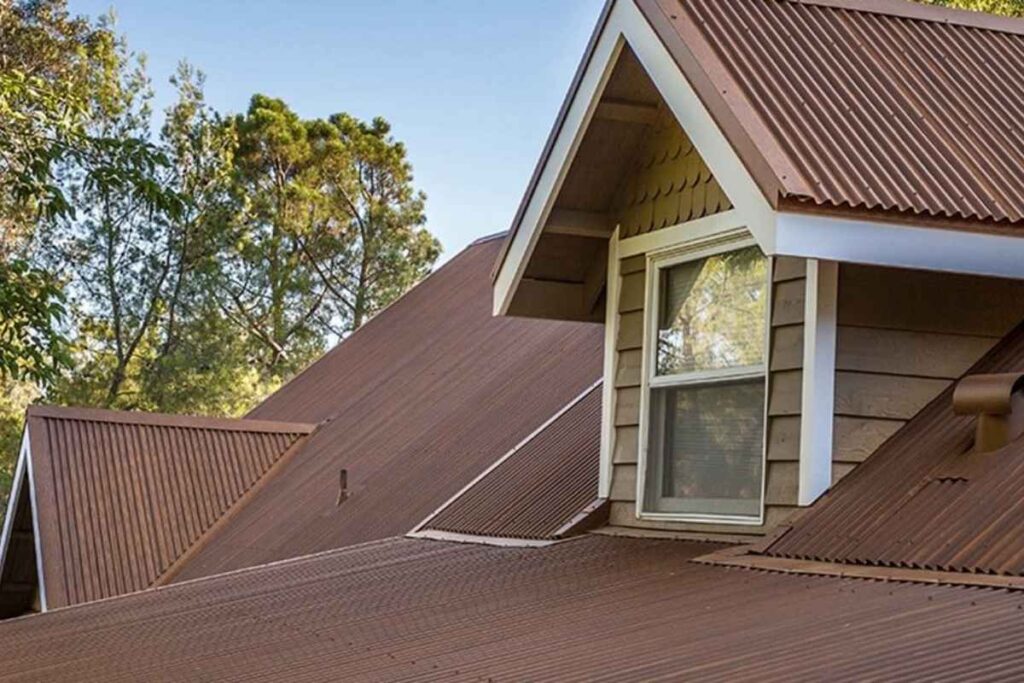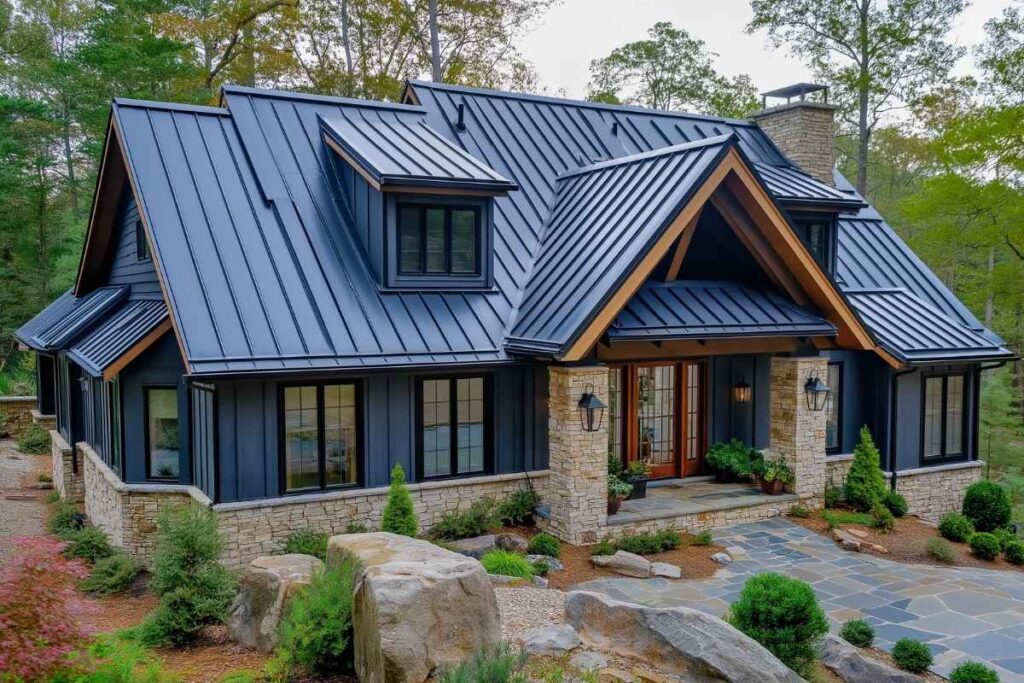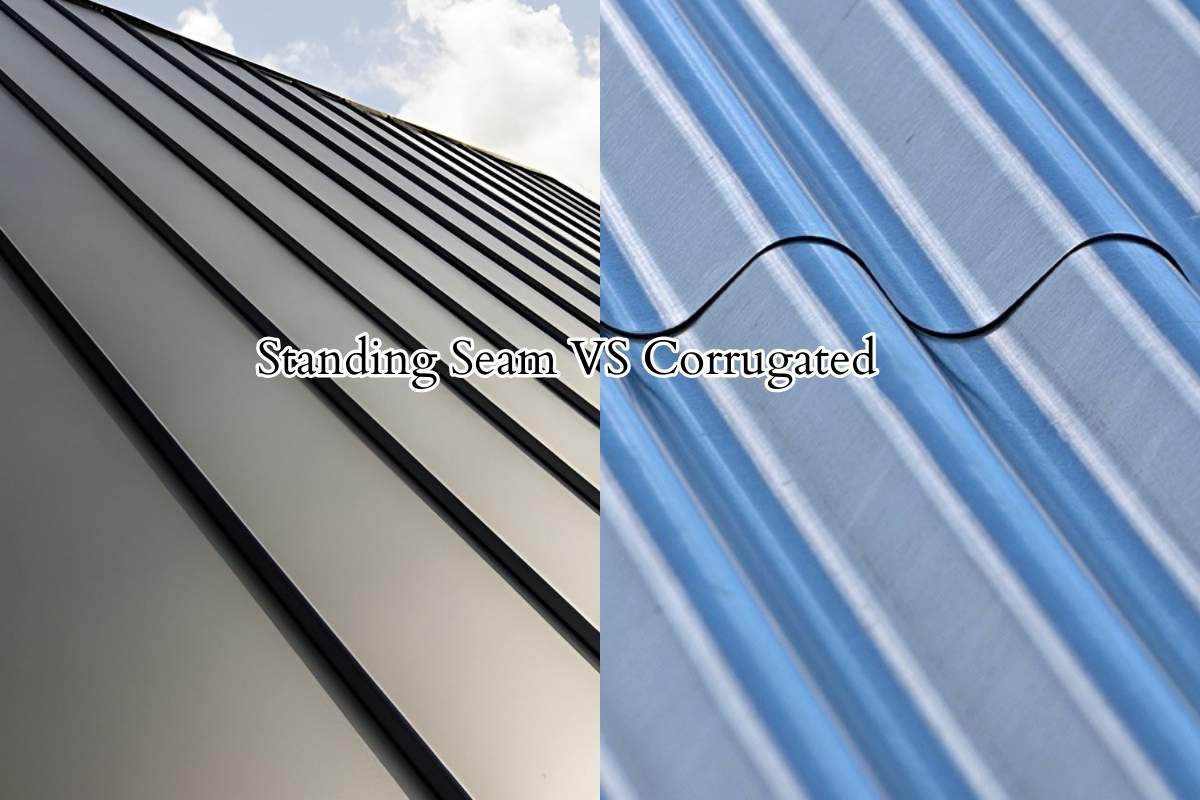Metal roofs stand out in the construction industry with their remarkable 75-year lifespan, far surpassing traditional asphalt shingles that typically last only 15 to 25 years. When comparing standing seam vs corrugated metal roof options, homeowners face an important decision that affects both their budget and long-term satisfaction.
Standing seam metal roofs offer superior leak protection with their concealed fastener design, while corrugated metal roofs provide a more budget-friendly option, costing approximately 50% less in both materials and installation.
In fact, each type brings distinct advantages – standing seam metal roofs excel in energy efficiency and modern esthetics, while corrugated metal roofs deliver durability with their characteristic wavy pattern at a more accessible price point.
Let’s examine the key differences between these two popular metal roofing systems, helping homeowners make an informed decision based on their specific needs, budget, and style preferences.
Metal Roof Basics Explained
The fundamental differences between standing seam vs corrugated metal roof systems lie in their design, installation methods, and performance characteristics. Understanding these distinctions helps homeowners make informed decisions about their roofing investments.
What is a standing seam metal roof
Standing seam metal roofs feature wide, flat panels with raised vertical legs on each end that interlock seamlessly. Moreover, these panels utilize a concealed fastener system, ensuring all attachments remain hidden beneath the vertical legs. Additionally, the panels attach to the roof deck either through a series of clips or by direct fastening underneath the standing seam.
These standing seam systems offer multiple customization options through various panel profiles, seam heights, and fastening methods. The panels come in different materials, including aluminum, steel, and copper, providing exceptional durability and weather resistance.
What is a corrugated metal roof
Corrugated metal roofing consists of roll-formed metal sheets shaped into alternating ridges and grooves. These panels typically come in two standard variations: ⅞-inch and ½-inch corrugated profiles. The distinctive wavy pattern significantly enhances the panel’s structural strength compared to flat sheets.
Furthermore, corrugated panels employ an exposed fastener system, where screws penetrate through the panel’s surface to attach directly to the roof deck. These panels overlap at their curved portions, creating a secure connection between adjacent sheets.
Key differences at a glance
The standing seam vs corrugated metal roof comparison reveals several crucial distinctions:
Installation and Fastening:
- Standing seam systems utilize concealed fasteners, significantly reducing the risk of leaks
- Corrugated panels feature exposed fasteners that require regular inspection every few years
Weather Resistance:
- Standing seam roofs demonstrate superior weather-tightness due to their interlocking design
- Standing seam systems can withstand Category 4 hurricane-force winds
Maintenance Requirements:
- Standing seam roofs demand minimal maintenance owing to their concealed fastener design
- Corrugated systems need more frequent inspections to ensure fastener integrity
Esthetic Appeal:
- Standing seam offers a sleek, modern appearance with clean lines
- Corrugated panels provide a traditional, wave-like pattern that suits rustic designs
Thermal Movement:
- Standing seam systems accommodate natural metal expansion and contraction through their floating clip mounts
- Corrugated panels may experience stress at fastener points during temperature changes
Customization Options:
- Standing seam allows for mounting solar panels and snow retention systems without roof penetration
- Corrugated panels offer limited options for additional features due to their exposed fastener design
Cost Analysis: Standing Seam vs Corrugated Metal Roof Price

Price considerations often drive the decision between standing seam vs corrugated metal roof options. A thorough analysis of both initial costs and long-term expenses reveals distinct financial implications for homeowners.
Initial installation costs
The upfront investment for standing seam vs corrugated metal roof installations shows notable differences. Standing seam metal roofs typically range between $10.00 to $16.00 per square foot, with premium materials potentially reaching $30.00 per square foot. Labor costs constitute approximately 60% to 70% of the total project expense.
Conversely, corrugated metal roofs present a more economical choice, with costs ranging from $7.00 to $12.00 per square foot. Generally, corrugated panels cost about half as much as standing seam options. Moreover, the installation process for corrugated roofing requires less specialized skill, resulting in labor costs roughly 50% lower than standing seam installations.
Several factors influence the final price:
- Roof complexity and design
- Regional labor rates
- Contractor expertise
- Existing roof removal requirements
For instance, a complex roof design with multiple angles or elevation changes substantially increases installation costs. Similarly, regions with higher living costs, such as San Francisco or New York, typically command higher labor rates.
Long-term maintenance expenses
Despite higher initial costs, standing seam metal roof vs corrugated metal roof maintenance expenses tell a different story. Standing seam systems demand minimal upkeep throughout their lifespan, primarily requiring basic annual inspections and occasional cleaning.
Standing seam vs corrugated metal roof price differences become particularly evident over time. Corrugated roofs, although initially cheaper, often incur higher maintenance costs. The exposed fastener system requires regular inspection and potential replacement, especially in areas experiencing harsh weather conditions.
Consider these long-term financial aspects:
- Standing seam roofs typically last 40-70 years
- Metal roofs become 50% cheaper than traditional options after 15 years
- Insurance companies frequently offer 10% to 35% premium discounts for metal roof installations
- Corrugated metal roofs usually require fastener replacement and more frequent maintenance checks
The standing seam metal roof vs corrugated installation demonstrates superior durability, particularly concerning weather resistance and thermal movement. This enhanced performance translates into fewer repairs and replacements over time. Consequently, routine maintenance for standing seam roofs typically involves simple inspections and debris removal.
Corrugated metal roof vs standing seam maintenance schedules differ notably. The exposed fastener design of corrugated systems necessitates more frequent inspections to prevent potential leaks and address rust development. These ongoing maintenance requirements can offset some of the initial cost savings.
Energy efficiency also impacts long-term costs. Metal roofs reflect heat effectively, potentially reducing cooling expenses. This reflective property, combined with proper installation, can lead to significant energy savings over the roof’s lifetime.
For budget-conscious homeowners weighing standing seam vs corrugated metal roof options, the decision involves balancing immediate costs against long-term value. Although corrugated systems offer substantial upfront savings, standing seam roofs often prove more economical when considering the entire lifecycle, including maintenance, durability, and energy efficiency benefits.
Performance Comparison
When evaluating standing seam vs corrugated metal roof performance, rigorous testing reveals distinct advantages in weather resistance, durability, and energy efficiency. Third-party laboratories conduct extensive assessments to ensure these roofing systems meet stringent industry standards.
Weather resistance
Standing seam metal roof vs corrugated metal roof weather resistance capabilities differ substantially. Standing seam systems demonstrate superior protection against severe weather conditions, withstanding Category 4 hurricane-force winds. The concealed fastener design minimizes potential water infiltration points, therefore reducing leak risks.
In contrast, corrugated metal roofs utilize thousands of exposed fasteners that penetrate the panels. These penetration points require regular inspection since loose fasteners can compromise the roof’s weather-tight seal. Standing seam panels, typically manufactured between 22 and 24-gage thickness, offer enhanced protection against severe weather conditions and maintain structural integrity under high winds.
Durability factors
The standing seam metal roof vs corrugated installation method significantly impacts long-term performance. Standing seam systems undergo rigorous testing for:
- Air leakage resistance
- Water penetration prevention
- Impact resistance
- Wind uplift capacity
- Fire and combustion resistance
These panels accommodate natural thermal movement through their floating clip mounts. Accordingly, this design feature prevents stress accumulation at fastener points, unlike corrugated systems which may experience strain during temperature fluctuations.
Both roofing types achieve Class A fire ratings, the highest classification according to UL 790 standards. Nevertheless, standing seam systems excel in hail resistance, earning the highest Class 4 rating under UL 2218 testing protocols.
Energy efficiency
The corrugated metal roof vs standing seam comparison reveals notable differences in thermal performance. Metal roofs can reduce cooling costs by up to 40% through their reflective properties. Standing seam systems demonstrate superior energy efficiency because:
- Their design creates additional airspace beneath the roofing material
- The raised seams enhance ventilation
- The continuous panels minimize heat transfer points
Standing seam installations on battens maximize energy savings, improving efficiency by up to 48.7% compared to traditional roofing materials. Even direct-to-deck installations boost energy efficiency by 30.3%.
The performance gap between standing seam vs corrugated metal roof systems becomes evident through scientific testing. Standing seam’s concealed fastener design, superior gage thickness, and advanced installation methods deliver enhanced protection against environmental challenges. Subsequently, these features translate into better long-term performance and increased energy savings for homeowners.
Installation and Maintenance Requirements
Proper installation and regular maintenance determine the long-term success of metal roofing systems. The complexity and precision required for each type directly impact their performance and longevity.
Standing seam installation process
The installation of standing seam metal roofs demands meticulous attention to detail and professional expertise. Before installation begins, contractors must inspect the existing roof structure to ensure it can support the weight of metal materials. The process involves:
- Installing a high-heat ice and water shield underlayment over clean decking
- Placing lock strips at the eaves and rakes
- Cutting panels at the rib bottom for proper attachment
- Installing clips with gimlet screws on vertical seams
- Snapping subsequent panels into place
- Adding Z-bar between panel ribs and ridge
The standing seam vs corrugated metal roof installation requires specialized knowledge in various construction aspects, from carpentry to plumbing.
Corrugated metal roof installation
The corrugated metal roof vs standing seam installation follows a more straightforward approach. The process begins with proper deck preparation and underlayment installation. The exposed fastener system makes corrugated panels easier to install. Key installation steps include:
- Measuring and cutting panels to size
- Installing underlayment and drip edge
- Securing panels with exposed fasteners
- Overlapping panels for proper water drainage
- Installing closure strips and ridge cap
Standing seam metal roof vs corrugated installation times differ considerably, with corrugated systems typically requiring less time to complete. Make sure you hire a reputable company to ensure a smooth installation process. Onsite Metal Roofing provides durable, efficient roofing solutions tailored to protect homes and businesses with lasting quality.
Maintenance schedules and tasks
The standing seam metal roof vs corrugated maintenance requirements present distinct differences. Standing seam systems need minimal upkeep beyond annual inspections of penetration points like vent pipes and skylights. In regions with extreme weather conditions, inspections should occur twice yearly.
Regular maintenance tasks for both systems include:
- Removing debris and cleaning panels
- Checking for loose or damaged fasteners
- Inspecting flashing and sealants
- Examining panel seams for separation
- Addressing any rust spots promptly
Corrugated metal roof vs standing seam maintenance differs primarily in fastener inspection frequency. The exposed fastener design requires checking every 5-10 years for potential replacement. Proper maintenance extends roof lifespan and preserves structural integrity, ultimately affecting standing seam vs corrugated metal roof price considerations over time.
Routine professional inspections help identify potential issues before they escalate into major repairs. These inspections become even more critical in climates with harsh weather conditions, where metal roofs face increased stress from temperature fluctuations and environmental factors.
Making the Right Choice for Your Home

Selecting between standing seam vs corrugated metal roof options requires careful consideration of specific factors that affect long-term satisfaction. Through years of experience in metal roofing installations, certain patterns emerge that guide homeowners toward the most suitable choice for their properties.
Climate considerations
Environmental conditions play a vital role in the standing seam vs corrugated metal roof decision. For coastal regions or areas with high salt exposure, aluminum standing seam panels offer superior corrosion resistance. Homeowners in locations experiencing severe storms should opt for the thickest available panel gage to ensure maximum protection.
Standing seam metal roof vs corrugated installations demonstrate different performance levels in extreme weather. Standing seam systems excel in areas prone to:
- Heavy rainfall and moisture
- High winds up to Category 4 hurricane force
- Substantial snow accumulation
- Intense UV exposure
Budget factors
The standing seam vs corrugated metal roof price comparison reveals significant differences. Corrugated panels match asphalt shingle pricing, costing approximately half as much as standing seam options. The installation costs follow a similar pattern, with standing seam requiring about 50% more in labor expenses.
However, long-term value considerations extend beyond initial costs:
- Standing seam systems demand minimal maintenance throughout their lifespan
- Corrugated roofs need regular fastener inspections and potential replacements
- Insurance companies often provide premium discounts ranging from 10% to 35% for metal roof installations
Style preferences
The esthetic appeal and designs caters to different architectural preferences. Standing seam panels create clean lines with a modern, sophisticated appearance. These systems remain flat except for their distinctive vertical seams, offering versatility in color selection.
On the other hand, their profiles present a more traditional, wave-like pattern that suits rustic or industrial designs. Both options provide extensive color choices, yet their fundamental appearance differs significantly:
Standing seam suits homeowners who:
- Prefer sleek, contemporary esthetics
- Value a low-maintenance design
- Need compatibility with solar panels or snow retention systems
Corrugated appeals to those seeking:
- Traditional wavy appearances
- Cost-effective solutions
- Simpler installation processes
The final choice between standing seam vs corrugated metal roof systems often combines practical considerations with personal preferences. Homeowners must weigh their specific climate challenges, financial resources, and desired architectural style to make an informed decision that serves their needs effectively Metal roofs are also commonly used on sheds and porches.
Standing Seam Vs Corrugated Metal Roof Frequently Asked Questions
Which metal roofing system offers better weather resistance?
Standing seam metal roofs provide superior weather resistance due to their concealed fastener design and ability to withstand Category 4 hurricane-force winds. They offer better protection against leaks and severe weather conditions compared to corrugated metal roofs.
How do the costs of standing seam and corrugated metal roofs compare?
Corrugated metal roofs are generally more budget-friendly, costing about half as much as standing seam roofs in both materials and installation. However, standing seam roofs may offer better long-term value due to lower maintenance requirements and potential energy savings.
What are the main esthetic differences between standing seam and corrugated metal roofs?
Standing seam roofs feature a sleek, modern appearance with clean lines and flat panels, while corrugated metal roofs have a traditional, wave-like pattern that suits rustic or industrial designs. Both options offer a wide range of color choices to match various architectural styles.
How do maintenance requirements differ between these two roofing systems?
Standing seam roofs require minimal maintenance due to their concealed fastener design, typically needing only annual inspections. Corrugated roofs, with their exposed fasteners, require more frequent inspections and potential fastener replacements every 5-10 years.
Which metal roofing system is more energy-efficient?
Standing seam metal roofs generally demonstrate superior energy efficiency. Their design creates additional airspace beneath the roofing material, enhances ventilation, and minimizes heat transfer points. This can lead to cooling cost reductions of up to 40% compared to traditional roofing materials.
Which metal roofing system is easier to install?
Corrugated metal roofing is easier and faster to install because it uses exposed fasteners and requires fewer specialized tools. Standing seam roofs, on the other hand, involve concealed fasteners and interlocking panels, making installation more complex and time-consuming.
Which option is more durable in the long run?
Standing seam roofs typically last longer due to their concealed fasteners, which prevent leaks and corrosion over time. Corrugated metal roofs, while durable, may require more maintenance as exposed fasteners can loosen or degrade with weather exposure.
Are both roofing types suitable for residential use?
Yes, but standing seam roofs are often preferred for modern homes due to their sleek appearance and durability. Corrugated metal is more common for barns, sheds, and industrial buildings but can also work for homes with a rustic or industrial style.
Which metal roof is better for high-wind areas?
Standing seam roofs generally perform better in high-wind conditions because their concealed fasteners and interlocking panels create a tighter seal. Corrugated roofs can still be wind-resistant but may require additional fasteners and reinforcements.
